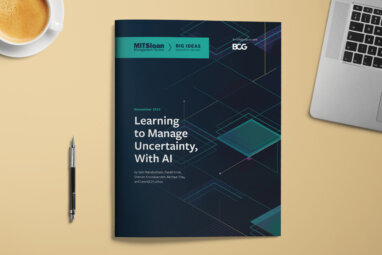Executing the CEO’s Agenda Through Targeted Learning
To execute on strategic goals and create competitive advantage, companies must embrace a learning function that looks different from what we know today.
Topics
The Future of Workplace Learning
Brought to you by
Skillsoft
Executing the CEO’s agenda almost always requires people within the organization to adopt new ways of seeing, thinking, and acting. Success requires learning at scale, with speed, in the places where it will matter most. This is easier said than done. For most companies, organizational lethargy — rooted in the familiarity of the status quo and legacy ways of working together — poses a significant risk for execution.
Learning is a valuable tool for CEOs to drive change. But in order to be deployed in a strategic way and unlock execution, learning needs to look different from what we know today. We’ve gathered perspectives and insights from dozens of CEOs and board members of large organizations in different industries across the globe and found that most CEOs lack a playbook for driving strategic learning. In this article, we propose the use of targeted learning as a vehicle to resolve key execution problems and social challenges, and to drive strategic change.
While traditional approaches to learning focus on individual aptitude and skill, targeted learning focuses on the ways individuals work together — in other words, on disrupting and rewiring social norms. It is a process that improves the way people collaborate in the course of day-to-day execution.
CEOs should take four actions to advance their agendas through targeted learning:
- Develop a holistic view of strategy execution challenges.
- Use targeted learning to intervene in the places that matter most for the CEO’s agenda.
- Measure impact through leading metrics linked to execution.
- Position the learning function to address strategic problems from the outset.
1. Develop a holistic view of strategy execution challenges. Leaders often define problems so that they can be easily solved, which is, of course, convenient. But this can lead organizations to oversimplify and focus too narrowly. Teams often spend their energy and time on new initiatives and project deliverables rather than understanding the complexity of the overall execution problems that reside within the whole system. To reverse course, leaders must define problems at the outset, holistically and systemically, so that they don’t become disparate initiatives isolated from strategy execution.
One Australian financial institution learned this lesson the hard way. After investigating misconduct in Australia’s financial services industry, a banking industry royal commission reached some painful conclusions. The final reports and recommendations it released in 2019 put a spotlight on risk culture and compliance that led to a surge in demand for relevant training. As a result, one bank required employees to complete 60 hours of pass/fail e-learning modules on risk each year. However, despite this effort, the risk profile of the bank didn’t improve. It had defined the problem too narrowly.
So instead of focusing on knowledge and compliance with training requirements, the organization’s leadership shifted to define the problem more holistically. What would an actual risk culture look like in teams — in terms of where they focused, how they cooperated, and what behavior they modeled and tolerated — if the company were to embody this ideal?
A holistic view enables organizations to look at the full scope of patterns, behaviors, and ways of working that need to change using targeted learning. They can pivot from looking at risk as a problem of individual competence to a more holistic problem of social collusion and legacy norms.
2. Use targeted learning to intervene in the places that matter most for the CEO’s agenda. Targeted learning works well for addressing priorities with significant social elements. Organizational work, after all, is social: It requires groups of people to work together, often in teams or across reporting lines, to make things happen. Here, targeted learning excels because it helps to quickly reshape how people work by looking at sources of power and why they currently work together in the ways they do.
Let’s return to the Australian banking institution. After leadership reframed the problem set with a holistic approach, the bank used targeted learning to address the social problems of risk within intact teams. One month each quarter was designated Team Risk Month, during which two team meetings were dedicated to robust dialogue and engagement around provocative prompts, videos, and short cases related to potential team risks. Team leaders were trained to lead these dialogues, and team members identified remedies and actions related to their work and then tracked and reported them. Using a technology platform to centralize activities, the bank developed tools, nudges, and targeted risk check-ins related to the team’s commitments and the organization’s risk profile. Training time on risk dropped by more than 50%. More important, teams took action on local priorities and changed their norms and, as a result, reduced organizational risks.
In another example, the new CEO of a natural resources company assumed his post wanting to drive a major culture change — what he called a “step-up culture,” in which individual employees felt compelled and enabled to take action and be accountable to make a difference in their daily operations. A holistic examination revealed that this agenda was being thwarted, unintentionally, by the company’s internal audit function. Internal auditors had deep professional knowledge around identifying and exposing corporate risks and problematic issues. However, this function’s legacy ways of working, which involved seeking out and punishing mistakes, were directly opposed to the kind of step-up culture that the CEO wanted to promote.
Insights into the social dynamics at play were key to tailoring the targeted learning approach. Rather than running a leadership program or culture change workshops, the learning team worked with the internal audit function to revamp core processes. The targeted learning intervention reoriented the team to focus on using its organizational influence to become “pollinators” of excellence, spotting and amplifying best practices rather than merely searching for mistakes. Changes to this process affected what they looked for, with whom they interacted, and the questions they asked. The refined approach also reshaped how they reported and telegraphed their findings.
The change in this lone functional process had a profound social impact. Teams looked forward to internal audits and were eager to learn from the auditors and have their best practices celebrated and taught elsewhere within the organization. This use of targeted learning, through another function’s core processes, did more to enable a step-up culture than a decade of leadership training would have accomplished.
By building an organization’s understanding of leverage and impact around the social dimensions of work and looking for the ways that teams, or specific types of teams, need to be unsettled and disrupted, new ways of working can take hold quickly.
3. Measure impact through leading metrics linked to execution. The results of targeted learning need to be measurable, long lasting, and strategic. Traditional measures of learning are less effective for this task because they focus on either satisfaction (for example, “To what extent was that program a good use of your time?”) or lagging indicators (for example, annual culture surveys or 360-degree assessments).
The intended impact of targeted learning must be identified from the start, along with a clear understanding of how it will drive the CEO’s agenda. Impact is defined by working backward from these chief priorities. Learning professionals need to understand what must shift to enable execution and where such changes will show up. Rarely does everything or everyone need to change to enable a CEO agenda. Sometimes, as the next example will explore, targeted learning aims to shift a set of applied behaviors in a critical, middle-management layer.
The CEO of a very distributed industrial manufacturing business wanted to advance the company’s safety agenda. Site leaders were critical to executing this priority. Research revealed that the best-performing site leaders received culture survey ratings from their teams that were 10 points higher than the average. These individuals also outperformed peers in both customer satisfaction and performance impact by double digits, and their sites were 37% safer.
Targeted learning research sought to go beyond describing behaviors in the abstract in order to detail how these leaders executed their roles day to day. The learning team determined that the most outstanding site leaders did two things differently: They spent almost 45% of their time in the field, teaching their teams; and they ran more engaging and social “prestart” meetings with their teams before beginning the day’s work. The learning team now had the metrics that could be pinpointed and assessed in real time. Site leaders were taught about the findings by their leaders (as a way to make this a part of their work, not adjacent to it). From then on, they were assessed every week on two things: how they were spending their time (based on calendar audits), and the quality of time in field and prestart meetings (using data from short team surveys). Over time, site leader efficacy in these two areas became a leading indicator for the safety function and their own performance, as well as overall operational excellence.
Effective targeted learning needs to translate the holistic view of strategy execution problems into vital measures that will underpin the design and approach of a given intervention. The learners themselves must have accountability for driving a return on the learning investment. People learn behaviors in organizations through many more avenues than we imagine, but individual culpability for changes is vital for impact. Measures for targeted learning need to offer transparency that allow people to see progress taking shape in their day-to-day work.
Targeted learning serves as a catalyst for transformational change: to address the tricky social problems that make or break world-class strategy execution and impede CEO agendas.
4. Position the learning function to address strategic problems from the outset. Most corporate learning functions focus primarily on building individual knowledge and skills. Targeted learning requires a shift in focus toward addressing systemic issues and building lasting change in organizational norms.
As an outfit designed to drive organizational change, the team responsible for targeted learning should include experienced learning professionals who are skilled at diagnosis, design, and facilitation. But such teams also benefit from drawing on business leaders with other backgrounds who “get” culture and the organization’s context. It is the combination of provocative thinking about behavioral change and learning, matched with the deep know-how and understanding of how things really work, that allows a targeted learning team to flourish.
The effectiveness of this group depends upon its ability to understand how to create leverage in the real social system of work that will advance CEO priorities quickly. The CEO needs to challenge this team to bring fresh thinking and an embedded architecture for enabling learning in the flow of real work. People behave the ways that they do, and learn, through myriad mechanisms within organizations; the targeted learning function needs to have authority to challenge the legacy ways of working that get in the way of the CEO’s agenda. Since the function is directly pursuing the CEO’s agenda, chief executives need to provide sponsorship to the group to address the critical leverage points that will drive impact and improve execution.
Targeted learning serves as a catalyst for transformational change: to address the tricky social problems that make or break world-class strategy execution and impede CEO agendas. By fostering this type of learning, CEOs can create organizations that can navigate the tumult and chaos of the modern era and leverage approaches to learning that are truly differentiating.









Comment (1)
Stuart Roehrl